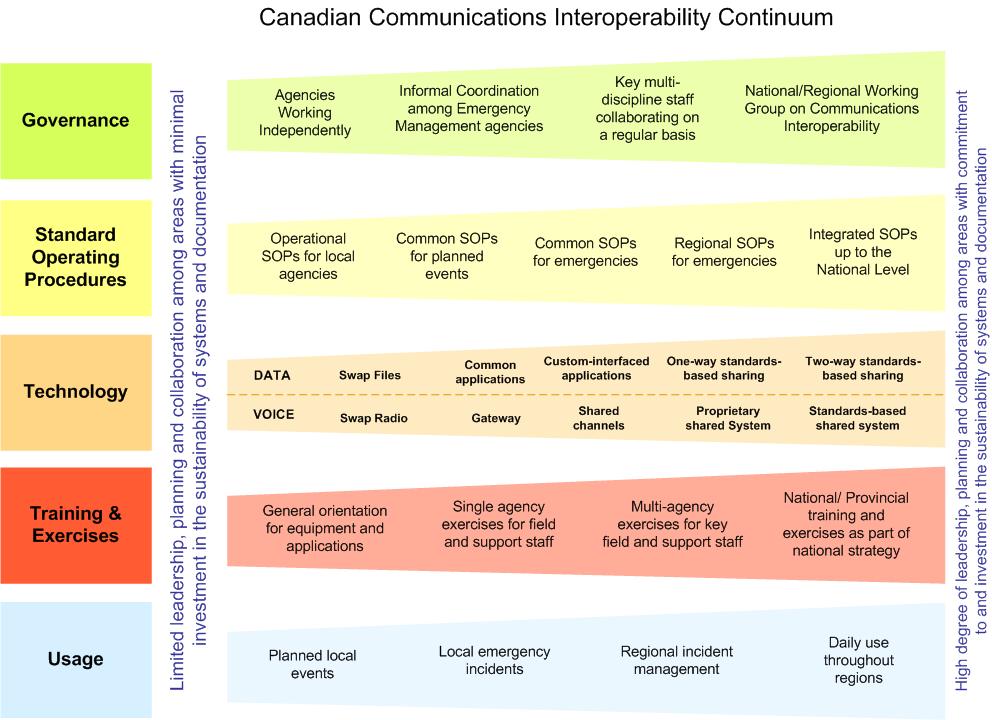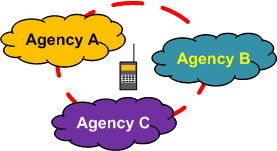Interoperability
|
Interoperability is ultimately about
relationships and trust. There must be a need and
willingness to communicate and share information, plus
each group must trust the other to live up to the shared
commitments and to not abuse any shared privileges.
Interoperability is a tool that can be used as part of an effective incident management solution. ICS / IMS / NIMS are the recognized solutions for effectively managing incident responses, especially involving multiple agencies. The use of interoperability and its effectiveness, depends on how well an incident is managed and how well the groups and agencies work together. The best Interoperability technology and SOPs are useless if people don't use them. |
 Interoperability Continuum |
| When developing interoperability solutions, it's a good idea to keep the KISS Principle in mind. When sitting at a desk, with lots of time, it's easy to develop solutions that may be overly complicated. Remember that the people using the solution are probably reacting to an incident and may never have spent time thinking about how to solve interoperability problems. |
Willing Partnerships Are Key To Success
Interoperability has different levels of
interest, understanding and accountability within each agency or
organization. For interoperability to be effective and used
regularly, it requires support from across the organization, no
matter what type of voice, video or data interoperability is
involved.
Senior Leaders
Senior Leaders must support and promote
cooperation and information sharing with partner agencies. Too
often the role of senior leaders is seen only as Governance,
setting high level direction and signing MOUs.
- In order for interoperability to actually work and be
effective, senior leaders must be interoperability champions
within their organization. This includes helping to ensure
there is funding to implement the new technology and write
SOPs, as well as funding to practice new interoperability
agreements. Senior leaders must also promote and demonstrate
the benefits of working with the partner agency. If daily
activities and comments of senior leaders demonstrate they
have no use for, or desire to work with, interoperability
partners, that message will flow down through the organization
and working level partnerships and cooperation with
interoperability partners will not develop.
Communications Systems and Support Staff
Communications system staff must ensure that
interoperability solutions are reliable, easy to use and
effective. Interoperability may have short term and long term
solutions, based on funding and system replacement time
lines.
- Simply connecting radios or systems together is not enough.
These interoperability connections need to be optimized for
quality and functionality, through internal efforts and
partner cooperation.
End Users In The Field
End users of interoperability need to
practice and use the interoperability on a regular basis, so
they become familiar with both the solution and working with
partners.
- In a crisis we fall back on what we know. If the
interoperability capabilities and partnerships have not been
used regularly, then they can be perceived as risky to use in
a crisis. Developing the partnerships with other agencies as
part of interoperability can identify strengths and
capabilities that are available through partners, that were
not known about before.
Radio Interoperability
 Interoperability is typically thought
of as a radio communications capability, where different
groups or agencies are able to communicate on scene,
using two way radio. Communications may be on shared
radios, common channels, or through system connections.
One of the often misunderstood concepts of radio interoperability is that interoperability is not about everyone being able to talk to anyone on their radio. Knowing who should be able to communicate and when is one of the components that should be thought through in advance and should be included in interoperability SOPs. One reason for not connecting everyone to anyone, is due to critical communications practices that must be followed in an emergency to ensure the life safety of those involved. For example, dispatch centres closely monitor activities in the field, to relay information between the scene and other parts of the organization and to issue critical notices like fire evacuation tones. Mixing different agencies, from different services, who are providing different on scene functions, onto a common radio channel or talkgroup, may actually cause more problems and increase risk. On the other hand mixing different agencies from the same service, can be beneficial. This might be different police agencies working together to provide security for an event, or different fire departments fighting a common fire. There are other situations, such as a strike team, where different agencies, from different services are mixed together effectively. This works because they are working as a team, to provide a common function and communications within the team is critical. Heavy Urban Search and Rescue (HUSAR) is an example of where mixed service teams may be used. |
Radio Interoperability Challenges & Considerations
|
Video Interoperability
There have been solutions to allow more than
one agency to share access to video cameras, as well as options
to hand off video saved on portable storage medium, but overall,
video interoperability is relatively new. With the migration to
IP cameras, higher bandwidth wireless solutions, the Public
Safety broadband initiative, and a general increase in
information sharing, video interoperability will become more
common.
Some of the challenges with video interoperability is the nature of video, which may capture information that is not related to the event, such as people walking by, how to connect networks together securely, and how to control who gets the video once it leaves the originators control.
Some of the challenges with video interoperability is the nature of video, which may capture information that is not related to the event, such as people walking by, how to connect networks together securely, and how to control who gets the video once it leaves the originators control.
IP Networks Security & Support
Radio communications, NG911 and security
systems are all IP enabled, allowing them to use standard
networking hardware, or connect over existing Public Safety and
enterprise networks. Applications anywhere on the network can
interface with the systems, expanding the functionality and
range of users. With this comes the need for more physical and
IT security to ensure the integrity and privacy of the
information on these systems.
These once independent IP networks now are
expanding beyond the physical boundaries of the organization, to
connect between systems in support of voice, data and video
interoperability. Connecting secure networks together is a bit
of a contradiction of keeping the network secure.
Maintaining the skills to configure and support a dynamic interconnection between secure networks may be a challenge for some agencies and organizations.Enterprise IT departments who were never involved before, may not be ready to meet the service levels required for these systems. This is just one of the new realities that must be thought through before implementing a new solution and system to system interoperability.
Maintaining the skills to configure and support a dynamic interconnection between secure networks may be a challenge for some agencies and organizations.Enterprise IT departments who were never involved before, may not be ready to meet the service levels required for these systems. This is just one of the new realities that must be thought through before implementing a new solution and system to system interoperability.